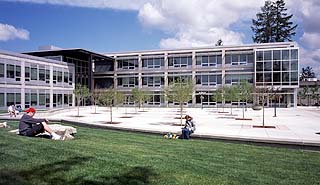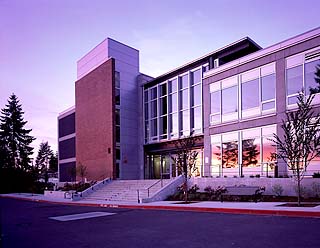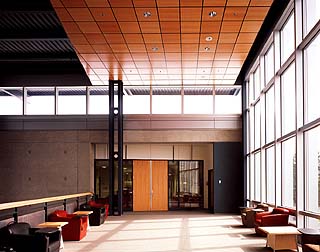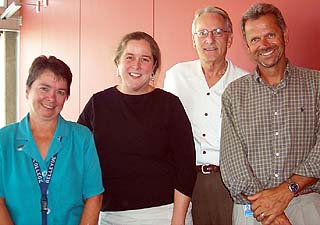|
Subscribe / Renew |
|
|
Contact Us |
|
| ► Subscribe to our Free Weekly Newsletter | |
| home | Welcome, sign in or click here to subscribe. | login |
Architecture & Engineering
| |
September 4, 2002
At BCC, a study in sustainable design
Special to the Journal

Photos by Ed LaCasse/LaCasse Photography The new classroom and office building at Bellevue Community College opens to a broad, tree-studded courtyard. Underneath the pavement, 97 deep wells anchor the geothermal heating and cooling system for the project. A second level inside allows students an excellent vantage point over the courtyard outside and the mall beyond.
|
A glance across the roofs of the Bellevue Community College campus will show that things are changing. The new R Building is different. Gone are the scattered rooftop boxes that must accompany conventional mechanical systems. Instead, clean lines and silvery paint greet the eye.
The ugliness we’ve grown accustomed to hiding overhead has been replaced by something beautiful underground. Water circulates through deep wells for heating and cooling, with endlessly renewable geothermal energy. This is just one of the many earth-friendly attributes of the new classroom and office building.
|
Bellevue Community College New Instructional Building (Building R) 3000 Landerholm Circle S.E., Bellevue |
|
Bellevue Community College Architect: LMN Architects John Nesholm, partner-in-charge Mark Reddington, design partner Jane Hendricks, project manager with Ken Hartz, Howard Howlett, Lisa Clark, Daniel Huang, Heather Sewell, Howard Meeks and Anna McCune Construction type: Cast-in-place concrete Project completion date: August 2001 Construction cost: $14.6 million Structural engineer: Skilling Ward Magnusson Barkshire Electrical engineer: Sparling Mechanical engineer: CDI Engineers Civil engineer: Rosewater Engineering Landscape architect: Van de Vanter Group Cost consultant: Rider Hunt Levett & Bailey Environmental consultant: Paladino Consulting Acoustical consultant: Michael Yantis & Associates Lighting consultant: Candela General contractor and construction manager: Mortenson Construction |
The L-shaped R Building, designed by LMN Architects, is an open book on sustainable construction and Modernist design values. The walls are a study in the transfer of weight through the exposed structure and the movement of light and air through the windows. Form and function become one in the visible layers of concrete framing, generous glazing and strategic shading. The aluminum wall of the classroom wing is slipped behind the concrete frame, setting up a layered rhythm of lines and patterns that is as expressive as it is functional. The pattern is repeated in the office wing, but the aluminum enclosure and windows fill in the structural grid.
It’s part of an evolving interest in the ways design and energy conservation work together, according to project manager Jane Hendricks. The Computer Sciences Building at the University of Washington, also designed by LMN, is another example.
With a new yearly student count of 22,000, Bellevue Community College has become the second-largest institution of higher education in the state. And with 68,000 square feet divided between a three-story classroom wing and two-story office wing, the R-Building is now the largest classroom building on BCC’s campus. Along with 33 classrooms, there is a dance studio in the basement. The addition of 52 faculty and staff offices will help to accommodate rapid growth.
In addition to serving as a demonstration of emerging green values, the R Building serves as a permeable wall that defines the contours of the original campus. A new master plan, also designed by LMN, departs from an earlier master plan on several points. Instead of emphasizing a single campus entry point and several formal elements, the new plan calls for multiple entry points to the campus. An evolving system of linked courtyards and plazas will tie together existing buildings with future buildings that will begin to form a second ring outside the present one.
The plan of Building R and its site sets up a civic vocabulary for campus. It is designed around indoor and outdoor public spaces and pathways through and around the building.
The visibility and transparency of the building bring drama and depth to several views of the campus. Pedestrians can see through two multi-story, glass-enclosed gathering and circulation nodes inside the R Building, and each of these in turn offer excellent views of the campus from a partial second level.
At end of the classroom building the glass wall projects outside the concrete framework in a kind of focal point and terminus for the campus. A glass-enclosed lobby at the knuckle of the "L," offers spectacular views of the Seattle skyline from the second-level vantage point, where students can also see an entrance to the building, the café counter inside the door and the courtyard just outside.

Viewing from the west, the classroom (at left) joins the office wing through the main entry. |
Don Bloom, manager of capital projects for the college, has embraced the value of non-programmed areas. "This is not a stop 'n' go mini-mart of education," said Bloom. "There’s a reason for people to stay."
That means the most important square footage in the building is in the social or civic spaces that make it a part of the campus. From meeting rooms to the informal study areas and the café, Building R is the new place to be. Tables in the court, the counter and café all offer well-designed invitations to pause and relax awhile.

Rich finishes, in the form of wood ceiling tiles and slate floors, are saved for the gathering spaces at the R Building. |
Great views are met with warm, saturated color and tactile finishes such as wood ceiling tiles and slate floors. "The tactile focus is in the public areas," said LMN's Hendricks.
Corridors in the classroom wing are unusually wide and tall, encouraging people to linger and interact while moving from one destination to another. Students can pause in groups and even sit on the floor without blocking traffic. The high, expose ceilings are free of ductwork because heat is distributed inside individual classrooms, fed by the hot and cold water pipes in the ceilings.
Inside classrooms, the connection of the walls to the structure is clear. The dropped ceiling stops short of the outer wall, allowing occupants to look up and see how the window wall attaches to the beams and faces the concrete frame outside. Light fixtures placed between wall and dropped ceiling emphasize the visible structure and layering of wall and ceiling elements.
Flexibility is at the top of the list of BCC’s priorities. Projections of student population from a decade ago were low by roughly half, so the college is determined to build in ways to accommodate different enrollment levels as well as changing trends in classroom configuration.
The office wing is designed so some of the office space can be converted to classrooms. The window wall on the classroom wing is set in five-foot modules so that classroom space can be reconfigured simply by moving interior partitions and changing heat pumps for individual rooms.

Photo by Clair Enlow Barbara Martin, vice president of administrative services at BCC; Jane Hendricks of LMN; John Carroll, director of operations and capital projects at BCC; and Don Bloom, manager of capital projects at BCC.
|
Although the success of conservation measures have exceeded his expectations, the college’s director of operations and capital projects, John Carroll, is not stuck in the numbers. He likes to remember the first day of classes last year, when students pushed their way into the new building early and stood in awe of the large, open lobby. He enjoys bringing VIPs in for a walk-through. The impact of the wide-open attitude and strong expression of the building is real, but hard to measure.
There are beautiful buildings, he said, but, "This building is stunning."
Taking the lead with LEED
Driven by the values of the college and supported by the city of Bellevue, the project will set new standards for environmental responsibility in the state college system and the city.
It is up for certification under the National Green Building Council’s LEED (Leadership in Energy and Environmental Design) program. LEED is a long checklist to evaluate design and construction against environmental costs and impacts. The R Building is competing for very high marks.
The list of environmentally sensitive and beneficial features is long and deep. Underneath the entry plaza embraced by the L-shaped building, water circulates through a grid of 97 wells and loops through Building R in a single system. Each well reaches to a depth of 300 feet, where the earth’s temperature is a constant 57 degrees Fahrenheit. Heat pumps throughout the building distribute and collect heat as water circulates between the wells and pipes in the new building.
Aluminum-based paint on the roof reflects solar energy to mitigate against "heat islands" associated with development and loss of habitat.
One of the cornerstones of the LEED program is the use of recycled and environmentally neutral materials. This means products are chosen for their low impact on the environment, in terms of pollution, as well as use of scarce resources and energy during production and transit. The R Building’s exposed concrete frame and steel lobby structure are partially composed of recycled material.
LEED gives points for indoor air quality as well, and the R Building scores high. Finish materials, including carpet, linoleum, adhesives and paint, meet the highest standards for non-volatility. In addition to clean installation, the finishes are selected for ease of maintenance and compatibility with environmentally neutral cleaning products.
The Building R’s storm drainage system filters and slows storm water runoff, using a 30,000 cubic foot detention tank installed under the parking lot at the rear of the building. There, storm water is filtered, run through an oil separator and then released at a rate specified to match the speed of release when the same land was wooded.
The building's systems show environmental responsibility and physical comfort can go hand in hand. Natural lighting not only reduces electricity use but also has been shown to improve academic and work performance. Classrooms have large, insulated windows to admit natural light, and sensors that automatically switch off electric lights when sufficient daylight is present. Shading and detailing in the architecture of the walls modulate glare.
All classrooms and offices have operable windows. Allowing the occupants to open windows requires adjustments among building maintenance personnel, who are accustomed to calibrating heat requirements based on conventional mechanical systems and a consistent set of variables. But according to John Carroll, director of operations and capital projects for the college, the exasperation of the staff is balanced by the satisfaction of building occupants, who have gained a sense of well-being and control of their environment.
In keeping with the emphasis on openable windows, the building’s ventilation system draws outside air into each classroom through the exterior wall rather than through a duct supplied by a central fan. This not only improves comfort but also saves energy and reduces materials required for ductwork.
The extra up-front costs of green choices have been carefully scrutinized in light of long term savings. The value engineering process for the building revealed the mechanical system, with its geothermal well field, would cost an additional $4.90 per square foot compared to a conventional system. But it would save the college 30 percent on heating costs, or at least $1 million over the life of the building. After the first year of service, it is clear savings will exceed that, according to Carroll. And while saving approximately 800,000 cubic feet of natural gas annually, the system also minimizes emissions of carbon dioxide, a greenhouse gas.
The initial costs of other special features were only marginally higher than more conventional systems, while offering significant operating benefits. For example, the building’s high-performance glazing system added approximately $1.70 per square foot to the overall cost as compared to a conventional two-element curtain wall system, but it is expected to improve occupant comfort and performance. The silvery Energy Star roof coating added $0.11 per square foot to the construction cost, but reduces mechanical system loads.
Waterless urinals are comparable in cost to conventional fixtures, but with the electronic faucets they are expected to cut water use in the building to half that used by conventional fixtures. The urinals, which have evolved from fixtures developed for marine applications, are designed around gravity and a chemical seal. In addition to saving 137,000 gallons per year water, they reduce maintenance costs.
Clair Enlow can be reached by e-mail at clair@clairenlow.com.
Previous columns:
- A retreat for teens ends decade-long run-around, 08-07-2002
- A once lackluster hall now scans the heavens, 07-03-2002
- Design team got a workout at Hec Ed, 06-05-2002
- A terra cotta shell for intimate dining, 05-01-2002
- Serious, modern City Hall, with a friendly barn door, 04-03-2002
- Tiny Mercer Island chapel solves a small, tricky problem, 03-06-2002
- Temporary library makes a lasting impression, 02-06-2002
- Signature identity on a human scale, 01-09-2002


